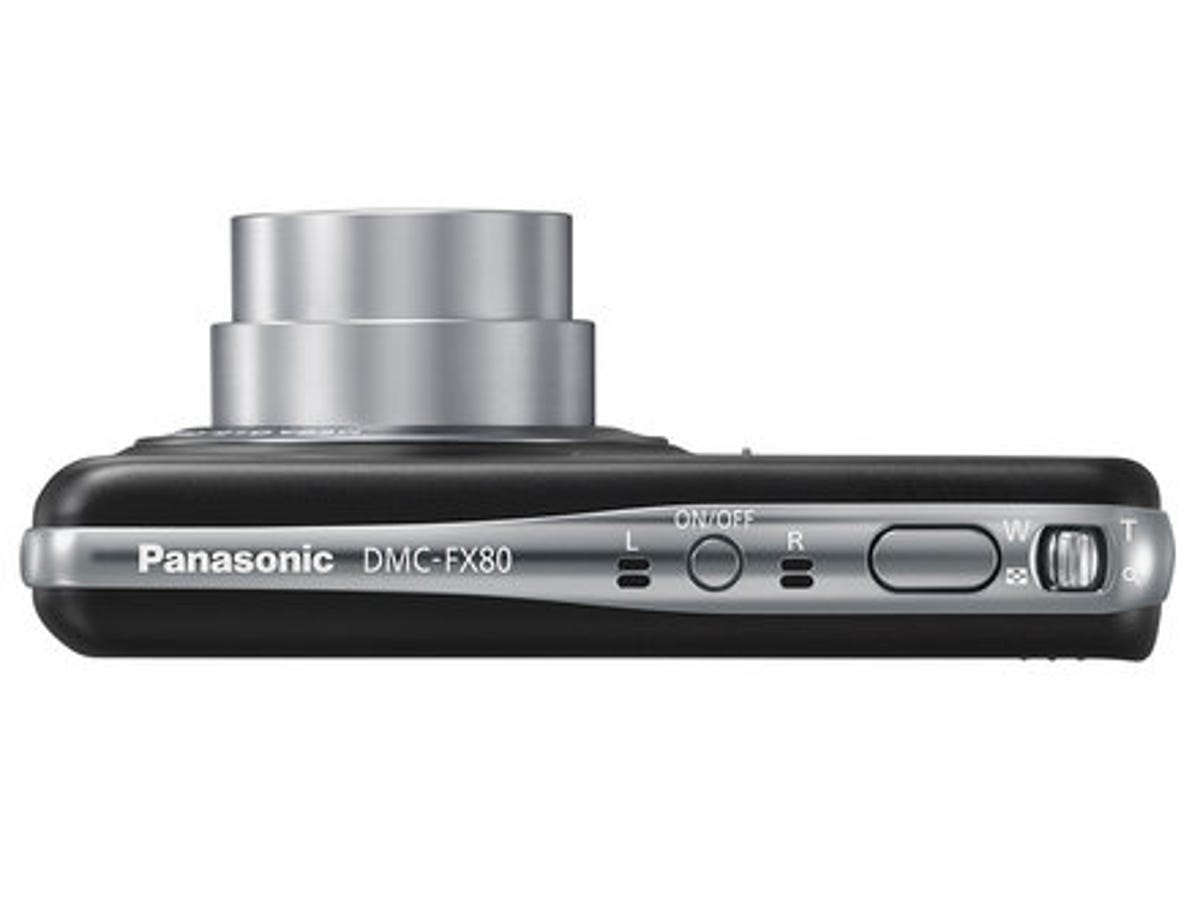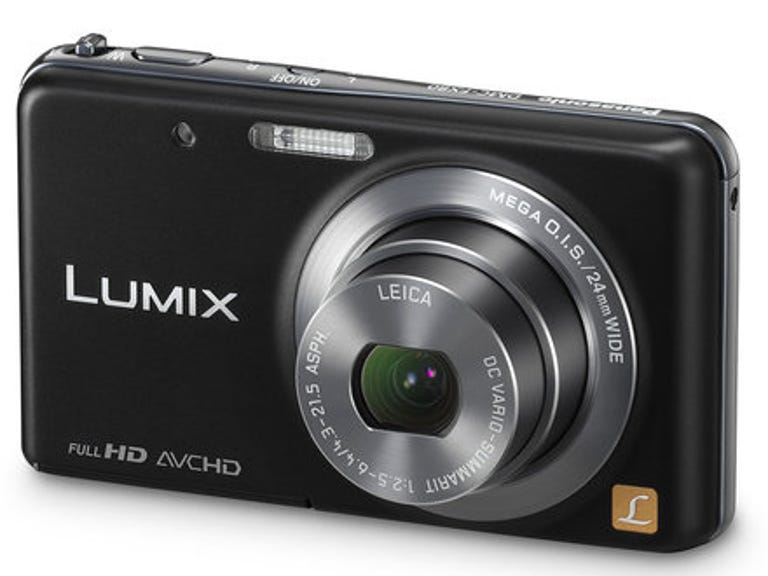 Why You Can Trust CNET
Why You Can Trust CNET Panasonic Lumix DMC-FX80 review: Panasonic Lumix DMC-FX80
An ultra-compact in every sense, the Panasonic Lumix DMC-FX80 is great for photo novices.
Measuring only 19mm front to back, the Panasonic Lumix DMC-FX80 is very thin. It slips comfortably into a jeans pocket -- even a back pocket (just remember to remove it before sitting down).
The Good
The Bad
The Bottom Line
Those dimensions are about double the thickness of a smart phone, yet because Panasonic has kept everything in proportion, it's actually a much better shape and weight for shooting stills than a phone could ever be. The addition of a subtle texture at the top of the rear casing also helps you keep a grip.
You can buy the Panasonic Lumix DMC-FX80 now for £200.
Build
The controls have been kept to the absolute minimum. The top of the chassis sports power, shutter and zoom controls, while the only two buttons around the back are for video recording and picture review.

The sensor has a native resolution of 12.1 megapixels, delivering JPEGs of 4,000x3,000 pixels. This sits behind a 24-120mm lens (as a 35mm equivalent, for a 5x optical zoom), with maximum apertures of f/2.5 at wide angle and f/6.4 at full telephoto. That wide-angle aperture is particularly impressive, allowing for bright shots in darker situations and shallow depths of field in portraits.
Sensitivity runs from ISO 100 to ISO 1,600 in regular use, with an optional high-sensitivity setting that will push it as high as ISO 6,400 should you really need it. The shortest possible exposure is 1/1,600 second and the longest a full 8 seconds, which is respectable for a camera in this class. Many rivals cap it at around 1 second in regular use.
There's no external charger, which is a mixed blessing. On the one hand,
it means you don't need to pack anything other than the adaptor and USB
cable to charge the battery on holiday. On the other, it means you
can't leave the battery charging at home or in your hotel room while you
head out shooting with a spare.
Shooting modes
I performed my tests with the FX80 set to Intelligent Auto, relying on the firmware to select the most appropriate setting for each shot.
There are no program or manual modes, nor shutter or aperture priority. But there are 15 scene modes covering off the usual bases such as portrait, landscape and sunset. Add to that an automated 3D mode that creates images for playback on 3D TVs when you sweep the lens across the scene, 10 'creative' options that make your pictures look like they were shot with old film, using tilt-shift lenses and so on, and an intriguing cosmetic mode. The latter lets you change the look of a subject's skin tone with options for soft, natural and summer, which is described as 'healthy tanned skin' in the manual (effectively a digital spray tan).
The creative control settings are a very effective way to boost the colour in otherwise dull shots if you're shooting in less than favourable conditions. The 'expressive' setting produces very punchy natural tones but you'll need to use it with care.
In the shot below, it's really lifted this pastoral scene of a red brick church and green corn field. Although the sky was pale blue, none of the colours were this vivid in real life, yet the result is balanced and appealing.
However, the green in the foliage beside this stream has been pushed a little too far and the result is rather artificial.
The lack of shutter and aperture priority modes is no surprise for a camera in this class, but it's a shame there's no control over the aperture in a camera with such a bright lens.
Stills tests
Although it did a great job of balancing colours and luminance, it didn't always achieve quite the result I was after. When shooting the bridge below, for example, it self-selected an aperture of f/2.5. This is its widest possible setting. Although it may have done this to avoid ramping up the sensitivity by allowing in more light (I was shooting under overcast skies and it had already increased sensitivity to ISO 250), it naturally led to a shorter depth of field than I had been hoping for. Weeds at the front of the bridge are sharp and focused but the trees at the back are blurred.
It's therefore well worth exploring the scene modes if there's a particular shot you want to take and the FX80 can't quite work out what you're after.
Macro performance is impressive. Minimum focusing distance in this mode is 5cm, from which point it maintains a very shallow depth of field and picks out a wealth of detail that's difficult to see with the naked eye, such as the ribbing on the label below.
In more conventional settings, the minimum focusing distance at wide angle is a less ambitious 50cm and double that at full telephoto. Results were consistently sharp though. There was no evidence in my tests of unwanted colour fringing on sharp contrasts, indicating the Leica-built lens had done a decent job of keeping all the visible tones of incoming light focused in sync.
Despite this, there is some evidence of barrel distortion, revealed when shooting a test grid. A perfect result would see each horizontal and vertical line running parallel. As can be seen below, there's some bulging out at the centre.
Low light performance was impressive in my tests. It's not possible to manually set the sensitivity so I disabled the flash to force it to self-select a higher setting.
Naturally, there was a fair amount of dappled noise in the result achieved at ISO 1,250, exposed for 1/8 second at f/3.6 under poorly-lit conditions. Colours were accurate though, and it was still possible to read the writing on the back of food tins.
Switching to the dedicated night scenery mode improved things greatly. This increased the exposure time to 1.3 seconds (so you'll need a tripod or something to lean the camera on), but knocked down the sensitivity to ISO 100 and left the aperture where it was. Much of the noise disappeared for a cleaner, more accurate result.
Video test
The FX80 shoots high-def video at 1,920x1,080 pixels at 50 frames per second interlaced or 1,280x720 pixels at 50fps progressive. It also films either of those resolutions at 25fps progressive or 640x480 pixels at 25fps.
There's an option to reduce wind noise, which you can switch to auto or off. I set it to auto throughout my tests, but it wasn't sufficient to eliminate the sound of a pretty stiff breeze that was blowing while filming.
That's a shame, as when you're sheltered from the wind, the soundtrack is very cleanly recorded with distant, quiet sounds clearly picked up.
Colours are accurate, although there was an occasional mild bleaching when zooming, which quickly corrected itself. The zoom was quiet enough not to be audible on the captured footage.
Conclusion
The FX80 is a good-looking, extremely slim camera that will suit anyone who is searching for a simple point-and-shoot that takes care of the technical side of photography for you.
It produces decent results, so long as you're happy to work within the auto or scene modes. If you're looking for a camera with which to learn and develop your photography skills, you may find it a little limiting. If that's the case, check out the Panasonic Lumix DMC-TZ25 instead.


